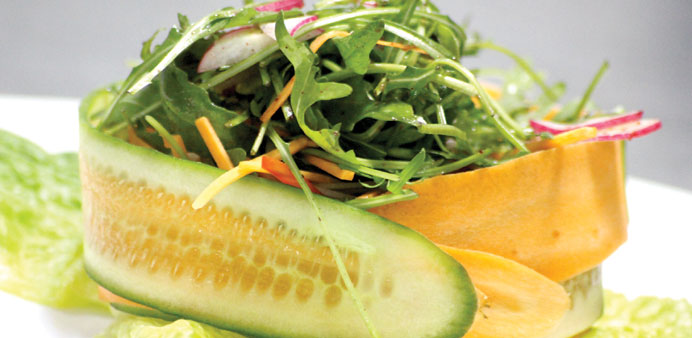Commonly known as roquette, rocca, rocket or jarjeer, arugula is a leafy vegetable resembling a longer-leaved open lettuce. It is rich in vitamin C and potassium. In addition to the leaves, the flowers, young seed pods and mature seeds are all edible. The plant is native to the Mediterranean region. The reason why it is called rocket is still very unclear.
Arugula has a peppery flavour that is exceptionally strong for a leafy green. Popular in the Middle East, the leaves are frequently used in salads and often mixed with other greens. In a young plant, the green leaves appear identical to that of spinach without stems.
Arugula is a low-calorie vegetable. As much as 100g of fresh leaves provides just 25 calories. Nonetheless it has many vital phytochemicals, anti-oxidants, vitamins and minerals that can be beneficial for health.
Fresh arugula is available in the market all through the year. While buying, look for crispy green young leaves. Avoid flowered harvest as its leaves are tough and bitter in taste. Discard any bruised, slumped leaves and stems before storage. The below mentioned recipe is simple and easy to make, does not require much ingredients, and can be prepared within minutes.
Mediterranean
arugula salad
Ingredients
(Serves 2)
Arugula leaves 1 bunch
White onion, sliced 1 no
Tomato, diced 1 no
Red radish, thinly sliced ½ cup
Cucumber sliced
Carrot sliced
Extra virgin olive oil 1 tbsp
Lemon juice ½ lemon
Sumac 1 tsp
Salt to taste
Method
Wash and dry arugula leaves and place in a salad bowl.
Add onion, red radish and diced tomatoes.
In a separate bowl combine olive oil, lemon juice, sumac and salt and whisk to combine.
Pour the prepared dressing on the arugula leaves and toss gently.
Once the dressing is all over the leaves, serve immediately, and pour the remaining dressing on top of leaves. Garnish with cucumber and carrot slices.
Note: Sumac, available as a ground spice in hypermarkets, comes from the dried berries of a shrub that grows wild in the Mediterranean areas. The taste is sour, fruity and astringent. The colour is reddish purple.
Basa fish
Basa is a type of catfish native to Vietnam and Thailand. It’s an important food fish with an international market. Basa is often labelled as bocourti, river cobbler, pangasius or panga, and is known for large white fillets, flesh that is moist with a light firm texture, and a mild flavour. One of the most versatile species ideal for restaurant or take-away meals, it’s equally suitable as a table fish to cook at home using a multitude of recipes and cooking styles.
Basa is a fast growing fish — so the cost of raising them is far less than for many other farmed species. They are easily harvested, and most farms are located in shore — close to the processing factories.
Black pepper crusted basa
Ingredients
(Serves 2)
Basa fish fillets 2 no
Olive oil 2 tbsp
Black pepper crushed to taste
Salt to taste
Lemon juice to taste
For sauce
Butter 2 tbsp
Garlic cloves 2- 3 no
Lemon juice 2 tbsp
Parsley, chopped 2 tbsp
Method
Wash and trim the fish fillet and cut into desired size, pat them dry.
Marinate with olive oil, salt, crushed black pepper, lemon juice and salt and refrigerate for 1 hour.
Melt butter in a heavy skillet over medium heat and saute chopped garlic for 1 minute, add fish fillet and cover.
Cook for 2-3 minutes on each side until the fish gets a crust and flakes easily with fork.
Remove fish on absorbent paper to remove excess oil and in the same skillet add butter and brown it.
Squeeze lemon juice and add chopped parsley and stir to combine.
Pour the prepared sauce on the fish and serve hot.
Note: Always marinate the fish with minimum seasoning and avoid adding too many ingredients in marinade to appreciate the real taste of the fish.
* Tarun Kapoor is executive chef at Doha’s Horizon Manor Hotel. Send your feedback to:
[email protected]

